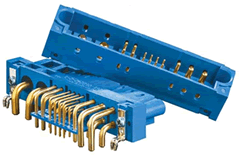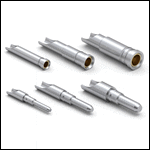How to Specify Connectors for Distributed Power Architectures
Selecting the right power connector will maximize efficiency in distributed power architectures.

Modular Scorpion connector from Positronic
Efficiency is the holy grail of today’s power system architectures. Higher-voltage DC distribution has its advantages and is gaining traction, but the utility of universal AC input with active PFC and attractive full load efficiencies continues to address complex load requirements. This is especially true for power-hungry low-voltage, high-current applications in data centers, network equipment, and other distributed power architectures. AC-to-DC power systems continue to be developed. Power components compete in speed and efficiency and power density is the new metric defining the unit performance in the marketplace.
Often the I/O connector is in one piece and is located at the rear of the unit featuring a mechanical blind-mating feature and sequential contact configuration to support hot swapping. These features are included by design, to enhance the connector’s performance characteristics.
What, then, is the major point of consideration when selecting a power connector? Is it price or performance?
Let’s look at the following example:
Application requirement – 1560W output at 130A continuous with maximum 30ºC rise

Conclusions:
- The second connector results in a 0.26% improvement in the PS unit efficiency.
- In one year of continuous 24/7 operation, the second connector saves 35.5 kWhours, which translates to more than $3 of savings.
- At some point through the third year of operation, the savings alone would exceed the initial purchase price of the connector.
It is surprising and notable for high-power conversion devices that only 0.25% improvement in efficiency results in a tangible operating cost improvement.
[hr]
Gaby Mindreci is sales organization manager for Positronic Europe.







